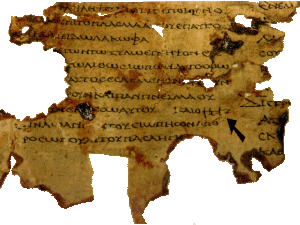Kaige

lower part of column 18 (after E. Tov) of the scroll of the twelve prophets by Nahal Hever ( 8HevXII gr). The arrow marks the tetragram in Paleo-Hebrew script
The kaige , or kaige revision, is a group of revisions to the Septuagint . They were created to better harmonize the translation with Protomasoretic Hebrew . The name "Kaige" comes from the constant use of the ancient Greek καί γε [ kai ge ], German 'and even' , around the Hebrew וְגַם [wə gam] to translate German “and also”. The importance of these revisions lies in their status as precursors to Aquila , Symmachus, and Theodotion , as well as in the light they shed on the sources of the Septuagint.
The individual characteristics of the kaige were first described by Dominique Barthélemy in relation to the role of the twelve prophets from Nachal Chever .
See also
Individual evidence
- ↑ Jennifer Mary Dines: The Septuagint: Understanding the Bible and Its World . A&C Black, London 2004, ISBN 9780567084644 , pp. 81-82.
- ↑ Timothy Michael Law: When God Spoke Greek: The Septuagint and the Making of the Christian Bible . Oxford University Press, Oxford 2013, ISBN 9780199344338 , p. 76.
- ↑ Emanuel Tov: Textual Criticism of the Hebrew Bible . Fortress Press, Minneapolis 2011, ISBN 9781451403299 , p. 143.
